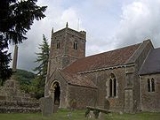
Church of St Andrew, Compton Bishop
Encyclopedia
The Church of St Andrewin Compton Bishop
, Somerset
, England dates from the 13th century, being consecrated by Bishop Jocelin
in 1236, with more recent restoration. It is a Grade I listed building.
The church has a 15th-century pulpit with tracery panels, carved frieze
s and cresting. Above the pulpit is a large pedimented wall monument to John Prowse who died in 1688, as well as several of his children.
The two stage tower with pinnacles and a stair turret has been dated to around 1380, although Harvey believes it is from the 15th century.
Compton Bishop
Compton Bishop is a small village and civil parish, at the western end of the Mendip Hills in the English county of Somerset. It is located close to the historic town of Axbridge...
, Somerset
Somerset
The ceremonial and non-metropolitan county of Somerset in South West England borders Bristol and Gloucestershire to the north, Wiltshire to the east, Dorset to the south-east, and Devon to the south-west. It is partly bounded to the north and west by the Bristol Channel and the estuary of the...
, England dates from the 13th century, being consecrated by Bishop Jocelin
Jocelin of Wells
Jocelin of Wells, also known as Jocelinus Thoteman or Jocelin Troteman, was a medieval Bishop of Bath and Wells. He was the brother of Hugh de Wells, who became Bishop of Lincoln. Jocelin became a canon of Wells Cathedral before 1200, and was elected bishop in 1206...
in 1236, with more recent restoration. It is a Grade I listed building.
The church has a 15th-century pulpit with tracery panels, carved frieze
Frieze
thumb|267px|Frieze of the [[Tower of the Winds]], AthensIn architecture the frieze is the wide central section part of an entablature and may be plain in the Ionic or Doric order, or decorated with bas-reliefs. Even when neither columns nor pilasters are expressed, on an astylar wall it lies upon...
s and cresting. Above the pulpit is a large pedimented wall monument to John Prowse who died in 1688, as well as several of his children.
The two stage tower with pinnacles and a stair turret has been dated to around 1380, although Harvey believes it is from the 15th century.

